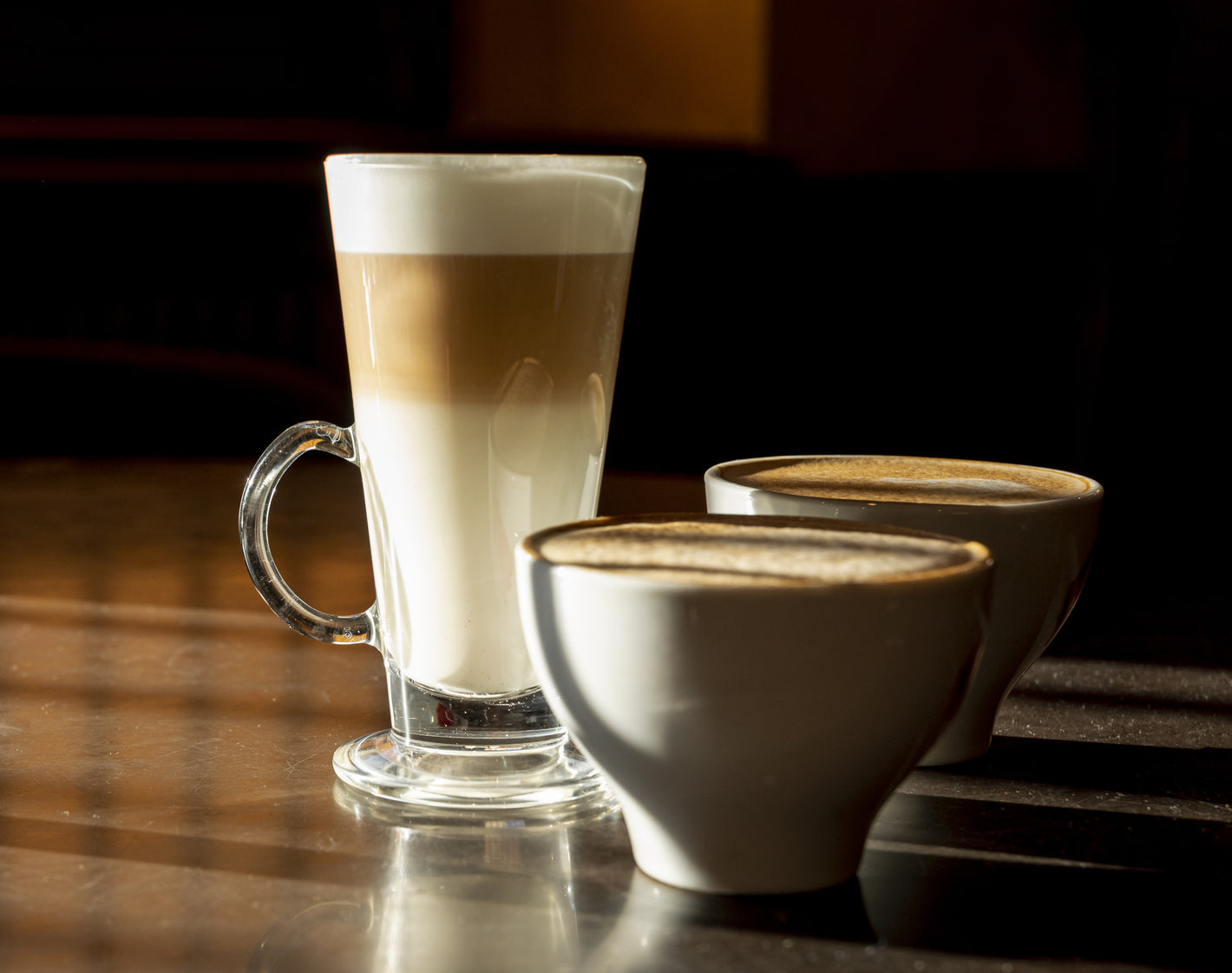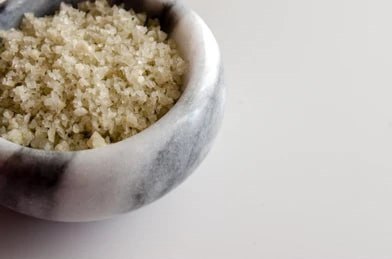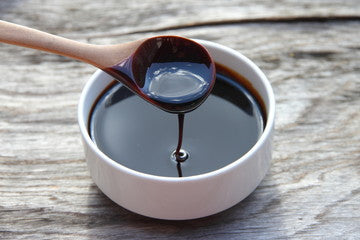Latte Macchiato: How Does It Differ from a Latte?

Related products
Are you a coffee enthusiast who often finds yourself standing in line at your favourite cafe, wondering what to order? Do you often find yourself stuck between a classic latte and the elegantly layered latte macchiato? What exactly sets these two beloved espresso drinks apart, and how do their flavours and textures differ? If you’ve ever thought about these questions. Let’s dive into the world of espresso drinks and uncover the distinct characteristics of latte macchiato and latte.
What is a Latte?
A latte, short for “caffè latte,” is an Italian coffee drink which means “milk coffee.” It typically consists of one or two shots of espresso combined with steamed milk and a small amount of milk foam on top. The result is a creamy, rich drink that balances the strong flavour of espresso with the sweetness and smoothness of milk.
Components of a Latte
Espresso: The heart of a latte, providing the strong coffee flavour.
Steamed Milk: Softens the intensity of the espresso and adds a velvety texture.
Milk Foam: A light layer that sits on the top of drink, enhancing its presentation and mouthfeel.

The Origin of Latte
The latte has a rich history in European, but its modern form is a more recent creation. While Europeans, particularly in Italy and Australia, enjoyed coffee mixed with milk for centuries, the latte as we know it originated in the United States.
In the 1950s, Lino Meiorin, an Italian American cafe owner in California, is often credited with popularizing the modern latte. He created it to cater to American customers who found traditional espresso too strong, adding more steamed milk to mellow the flavour. By the 1980s, the latte had gained widespread popularity.
What is a Latte Macchiato?
A latte macchiato, which means “stained milk”, takes a different approach to layering flavours. In this drink, steamed milk is the base, and espresso is poured on top, creating distinct layers of milk and coffee.
Components of a Latte Macchiato
Steamed Milk: The foundation of the drink, providing a creamy texture.
Espresso: Poured over the milk, it creates a beautiful contrast and layered effect.
Milk Foam: Often more prominent than in a traditional latte, it crowns the drink and adds a rich texture.

The Origin of Macchiato
Macchiato originated in Italy during the 1980s as espresso "stained" with a small amount of foamed milk. The name "macchiato" translates to stained (or spotted), referring to how the milk slightly changes espresso colour.
A simple, strong coffee with just a touch of milk The Espresso Macchiato was created for those wanting a balance between pure espresso and milk-heavy drinks. Over time, countries like the U.S. developed their own versions such as a Caramel Macchiato, which are much from each other and can be sweeter or larger in size. The changes continue, but the macchiato is a time-honoured favourite because it has both boldness and balance.
Key Differences: Latte vs. Latte Macchiato
Although both drinks contain very close ingredients, but due to some secret preparation and presentation one has no replacement taste experience for another. Let’s explore these differences in detail.
1. Preparation Method
Latte: The espresso is made on its own and then it combines with steamed milk. Mixing the two ingredients makes it a homogenous drink. The milk, usually lightly frothed to produce a silky texture.
Latte Macchiato: The process is reversed. It is poured into a glass first with steamed milk followed by the espresso, which then carefully follows suit. The coffee floats heavier on the milk and it ends up looking beautifully layered.
2. Visual Appeal
Latte: When served, a latte appears as a uniform creamy colour. The slight foam on top can be artfully designed with latte art, but the overall look is more blended.
Latte Macchiato: The layered presentation is one of its most appealing features. I personally like sipping through each layer to reach that major coffee bomb at the bottom. Dark espresso sits on top of a bed of lighter milk, and it's often served with the most gorgeous gradient!
3. Flavour Profile
Latte: It has a creamy, well-rounded flavour profile with the milk smoothing out some of the bitter espresso. It's a rich, soothing beverage that tastes good to most people.
Latte Macchiato: The first sip may present a stronger coffee flavours since the espresso is not mixed in with the milk. As you drink, the flavours blend more, but the initial taste can be more pronounced, offering a unique experience.
4. Milk-to-Espresso Ratio
Latte: Generally, a latte has a higher milk-to-espresso ratio, making it creamier and less intense in coffee flavour. A typical latte contains one part espresso to about three parts milk.
Latte Macchiato: While the milk is still the dominant ingredient, the ratio can vary. If the espresso is poured in on top of your alternative milk, then you may taste that coffee flavour more instantly, especially if it's with lesser milk.
Preparation Methods: A Step-by-Step Guide
In this you can notice the most difference between making a Latte and a Latte Macchiato. The order in which the espresso and milk are combined, as well as the resulting visual presentation, significantly affect the flavour profile of each beverage.
How to Make a Latte
Ingredients:
1 shot of espresso
6-8 ounces of steamed milk
A dollop of milk foam
Instructions:
Make the Espresso: To make an espresso, brew one or two shots of espressos using your espresso machine. Espresso is what the drink comes with.
Steam the Milk: Steam until you have a thick and velvety milk using your espresso machine steaming wand. The milk should be heated to a temperature of around 150–160°F (65–70°C), and it should have a thin layer of micro foam on top.
Mix Espresso and Milk: Once the espresso is brewed, pour it into a cup. Immediately follow this by pouring the steamed milk into the cup, combining it evenly with the espresso. The milk dilutes the strength of the espresso, creating a balanced flavour.
Finish with Milk Foam: Finally, top the drink using just a touch of milk foam. You can now enjoy it along with soft air texture of foam that has managed to give this drink a real shine.
How to Make a Latte Macchiato
Ingredients:
1 shot of espresso
6-8 ounces of steamed milk
A generous layer of milk foam
Instructions:
Steam Milk: Same as the Latte process Steam the milk to your preferred consistency, with a light layer of foam on top. Pour the steamed milk into a tall glass, so that it fills around three-quarters of it.
Make the Espresso: Once your milk is steamed, pull a shot of espresso on to it using an espresso maker.
Pour the Espresso into Milk: Pour brewed espresso slowly over back of spoon in glass with steamed milk. The espresso then must pour over the milk and form that extra layer sitting on top of the creamy or frothy milk body responsible for Latte Macchiato signature layered effect.
Top with Foam: Add a spoonful of milk foam to the top of the drink to finish it off.
Is There a Difference in Size?
Is a macchiato much smaller than a latte? A macchiato is usually served in a tiny espresso cup, which holds approximately 59-89 ml or 2-3 oz.
It is a fast and strong coffee that should be sipped rapidly warming your palate. On the other hand, a latte is served in substantially larger tall cups than an espresso-based milk coffee at approximately 240 ml or more because it contains so much milk to balance up with the espresso. The latte is for those looking to extend their coffee experience.
Latte vs. Macchiato – What Should You Choose?
The choice between a latte and macchiato would be dependent on your liking or mood. The latte is perfect if you crave a treat that will last for more than a few sips. Its smoothness and size lend it well to sipping.
If you want to make your espresso last, a macchiato is perfect for quickly creating something very strong since it's short and intense. In the end, it comes down to what you like best. Now that you know the differences between them, you can choose your favourite coffee whenever next time to visit a cafe!
Latte vs. Macchiato – Which is Stronger?
The macchiato is traditionally the stronger of the 2 drinks, it provides a higher amount of coffee taste. A macchiato will normally be one part steamed milk to two parts espresso, and with just a smattering of foam on top. While modern variations often include sugars and syrups for added sweetness, these adaptations stray from the drink's original preparation.
On the other hand, a latte contains one shot of espresso paired with steamed milk and then frothy foam to finish. Most standard lattes are a 2:1 milk to coffee ration. Less foam in a latte means it basically becomes flat white.
People Also Ask
What is the best milk for making a latte?
The best milk for making a latte is typically whole milk as it perfectly creates the desired creamy texture and balances the espresso flavour throughout the portion. Non-dairy milk alternatives such as oat milk and almond milk also serves the purpose by creating a creamy consistency and adding a slightly different flavour to the latte.
Can you make a latte macchiato with non-dairy milk?
Yes, latte macchiato can be made with non-dairy milk. Popular options in non-dairy milk to make the perfect latte macchiato include oat milk, soy milk and almond milk as it works it way into making a creamy glass of latte macchiato along with adding their own distinct flavours.
Conclusion
A latte, short for “caffè latte,” is an Italian coffee drink which means “milk coffee.” It typically consists of one or two shots of espresso combined with steamed milk and a small amount of milk foam on top. The result is a creamy, rich drink that balances the strong flavour of espresso with the sweetness and smoothness of milk. The espresso is made on its own and then it combines with steamed milk. Mixing the two ingredients makes it a homogenous drink. When served, a latte appears as a uniform creamy colour. It has a creamy, well-rounded flavour profile with the milk smoothing out some of the bitter espresso. A latte has a higher milk-to-espresso ratio, making it creamier and less intense in coffee flavour.
A latte macchiato, which means “stained milk”, takes a different approach to layering flavours. In this drink, steamed milk is the base, and espresso is poured on top, creating distinct layers of milk and coffee. It is poured into a glass first with steamed milk followed by the espresso, which then carefully follows suit. The coffee floats heavier on the milk and it ends up looking beautifully layered. The layered presentation is one of its most appealing features. As you drink, the flavours blend more, but the initial taste can be more pronounced, offering a unique experience.
The latte is perfect if you crave a treat that will last for more than a few sips. Its smoothness and size lend it well to sipping. If you want to make your espresso last, a macchiato is perfect for quickly creating something very strong since it's short and intense.









 Rated Excellent by 26,523+ Reviews
Rated Excellent by 26,523+ Reviews